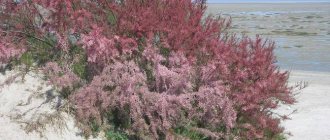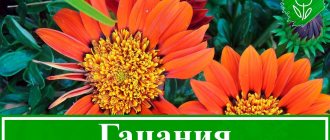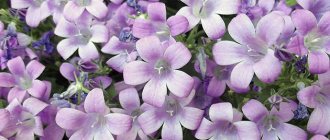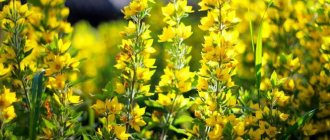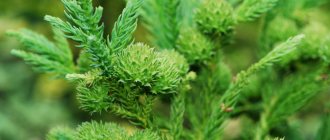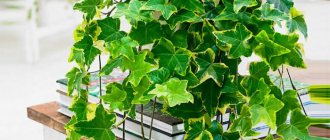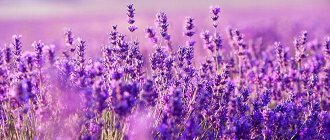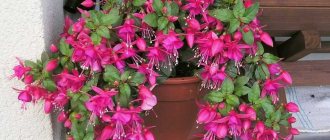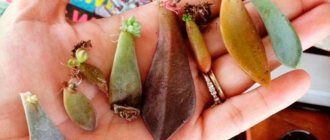Author: Elena N. https://floristics.info/ru/index.php?option=com_contact&view=contact&id=19 Category: Garden plants Published: February 17, 2019Last edits: January 13, 2021
- Growing conditions
- Common loosestrife (Lysimachia vulgaris)
- Medicinal properties
plant (lat. Lysimachia) is a genus of herbaceous perennials, annuals and biennials of the Primrose family. The plant is called loosestrife for the similarity of its leaves to the leaves of willow - this is what all types of willow were called in Rus'. The scientific name of the plant was given in honor of Lysimachus, one of the generals of Alexander the Great, who later became the ruler of Thrace and the king of Macedonia. For a long time it was mistakenly believed that it was he who discovered loosestrife. The genus consists of more than one hundred species. Most loosestrife species grow in the Northern Hemisphere, particularly in North America and East Asia - more than seventy loosestrife species grow in China. Some species grow in South America and South Africa. Loosestrife is found in the Caucasus, the European part of Russia and Central Asia.
Planting and caring for loosestrife
- Planting: sowing seeds in the ground - in June or before winter in September.
- Flowering: from the end of June for 6-7 weeks, sometimes longer.
- Lighting: partial shade or shade, but some species need bright light.
- Soil: fertile and loose, fertilized with rotted manure or compost, with high groundwater levels.
- Watering: only during periods of prolonged lack of rain.
- Fertilizing: not provided, only at the end of autumn the area is fertilized with humus.
- Restriction: this aggressive plant must be limited: dig sheets of slate, plastic or metal around the perimeter of the site.
- Reproduction: seeds, cuttings, root shoots and dividing the bush.
- Pests: aphids.
- Diseases: resistant to all infections.
Read more about growing loosestrife below.
Chemical composition
The widespread use of loosestrife in traditional and folk medicine, as well as the medicinal properties of the plant, are due to the chemical composition of its roots, leaves and flowers. It has been scientifically proven that these parts of the plant contain:
- Phenolcarboxylic acids and their derivatives;
- Tannins and saponins;
- Arginine and essential oil;
- Nitrogen-containing compounds;
- Rutin and primerase;
- Flavonoids and lactones;
- Hyperine and carbohydrates;
- Bitterness and tarry substances;
- Silicon and ascorbic acid.
Botanical description
Loosestrife grass is represented by annual, perennial and biennial plants with erect or creeping stems, simple, alternate, entire, whorled or opposite leaves. Loosestrife blooms with white, yellow or pinkish flowers, single axillary or collected in spike-shaped or corymbose panicles. The loosestrife fruit is a spherical or ovoid capsule. Loosestrife is a relative of plants such as cyclamen, milkweed, ambilanthus and primrose.
Loosestrife is an unpretentious plant and, despite its unpretentious appearance, is in demand in gardening: the flowering of loosestrife is distinguished by its abundance and duration. Planting loosestrife and caring for it will not seem labor-intensive to you. This article will describe planting and caring for common loosestrife, since it is the base species of the genus, especially since planting and caring for coin loosestrife or planting and caring for point loosestrife, as well as planting and caring for lily of the valley loosestrife have much in common with growing common loosestrife.
general information
Loosestrife is a large and diverse genus of herbaceous primroses. It got its name because of the shape of the leaves, which are similar to willow. Different varieties of loosestrife are distributed throughout the world: from China to South Africa, from the Caucasus to North America.
Loosestrife can be of any kind: annual and perennial, erect and creeping, with different shapes of leaves and inflorescences. There are varieties with lush flower panicles and with single buds. But with shades everything is simpler: mainly yellow, white and pink.
Photo: 7dach.ru
Planting loosestrife in open ground
When to plant
Loosestrife can be propagated by seeds and vegetative methods. Sow loosestrife seeds in the ground in June or September, before winter.
- Grapes: forming new sleeves - what you need to know
Almost all types of loosestrife grow best in shade or partial shade, and coin loosestrife, although it prefers the shade of trees, feels great in the sun. And only purple loosestrife prefers open sunny places.
How to plant
Loosestrife needs fertile, loose and moist areas with close groundwater, and species such as loosestrife, loosestrife, and common loosestrife can simply be planted in a reservoir to a depth of 10 cm. The composition of the soil for loosestrife is not of fundamental importance; it does not like only clay soils. Loosestrife is planted in soil fertilized with well-rotted manure or compost.
Loosestrife is planted like any other plant: the root system is placed in a hole, after which it is covered with soil, the surface of the area is compacted and watered. The distance between loosestrife bushes should be at least half a meter.
Choosing a landing site
For any variety, it is necessary to choose a site with loose, moist soil with an optimal composition of nutrients (preferably a high location of groundwater).
Common, coin, and racemose loosestrife are often planted in reservoirs whose depth does not exceed 10 cm. All species do not tolerate planting in clay.
When growing outside a pond, compost or rotted manure is added before planting. The holes are dug in advance, the roots of the plants are straightened, and a mixture of peat and sand is poured. The soil around the plants is compacted and watered abundantly.
Loosestrife care
Growing conditions
Planting and caring for loosestrife in open ground does not require much effort. Growing in moist soils, the plant frees you from the need to moisten the soil. The plant will only need to be watered during periods of prolonged absence of rain.
Caring for loosestrife does not involve fertilizing during the growing season, and only at the end of autumn it is necessary to fertilize the soil with humus.
Loosestrife is an invasive plant, especially species such as mottled loosestrife, ciliated loosestrife and racemosa. If you do not dig restrictions in the form of sheets of slate, plastic or metal around the bushes of the plant, it will spread throughout the garden. When the loosestrife has finished blooming, remove the faded inflorescences, and in the fall, trim the stems of erect loosestrife.
Loosestrife flowering
Each type of loosestrife has its own flowering time, and the flowers have their own degree of decorativeness, and we will tell you how and when this or that loosestrife blooms in the section on plant types and varieties.
Transfer
Growing loosestrife involves timely transplantation of the plant. Loosestrife can grow in one place in the garden for up to 10 years, but within two years after planting you will have a developed bush with many children that just need to be planted. Transplantation is carried out in early spring or autumn after leaf fall.
Pests and diseases
Loosestrife is surprisingly resistant to all such problems. The only trouble that can happen to it is an attack by aphids, but in this case you can always purchase the appropriate drug in the store - for example, Biotlin or Antitlin.
Landscape use
- Ordinary and spot varieties look good in mixborders in combination with speedwells and blue bells, multi-colored astilbes.
- The ciliated species prefers the proximity of anaphys, wormwood, and chistets.
- Ceramic loosestrife is a good option for a mini-garden of plants with white flowers.
- Monetary is used to cover the soil near ponds and create flowerpots (as in the photo of loosestrife flowers).
These plants are planted in the fresh air not only in the ground, but also in boxes on balconies, terraces, in containers, pots, garden vases and baskets, which are placed throughout the site. A variety with densely arranged yellow flowers with a red center comes from China.
The decorative effect is enhanced by dark pink shoots covered with gray fibers and a bronze underside of the foliage.
Planted in boxes, baskets, pots with standard soil mixture, located in partial shade. This plant blooms twice (in spring and autumn), and is moved to a cool place for the winter.
It reproduces by shoots with aerial roots that regularly appear on the stems.
Containers with loosestrife are placed in paved courtyards, in problem areas of the garden. Such plants reproduce in the spring by dividing those growing on the site.
Seedlings are available in online and offline stores. When placing vases or containers in the garden, protection from snails and slugs is required. Hanging baskets are safer.
Cut loosestrife lasts a long time, so it can be used in bouquets.
Reproduction of loosestrife
As already mentioned, loosestrife propagates by seeds and vegetatively - by dividing the bush, cuttings and root shoots. But experience shows that vegetative methods of propagating loosestrife are more reliable than seed propagation, especially since loosestrife from seeds blooms only 2-3 years after germination. Before sowing at the end of May or beginning of June, loosestrife seeds must be stratified for one and a half to two months in the vegetable drawer of the refrigerator. Before autumn sowing, there is no need to treat the seeds with cold - in the winter soil they will undergo natural stratification, and in the spring you will see friendly shoots.
You can use the seedling seed method: stratified seeds are sown on the surface of a moist substrate consisting of sand and peat, covered with glass and kept at a temperature of 15 ºC in a bright place. In ten to fourteen days, seedlings will appear, and when they get stronger, they are planted in separate containers and, after hardening procedures, planted in open ground in June, keeping an interval of 50 cm between seedlings.
In early spring or autumn, during transplantation, loosestrife can be propagated by dividing the bush. The loosestrife is dug up, the children are separated, then the bush itself is divided into parts so that each section has developed roots and shoots, after which all parts are planted. All these plants will bloom next year. Care for the planted parts as for an adult plant.
Monetary loosestrife is most often propagated by cuttings 10-20 cm long. Cuttings are carried out during autumn pruning or in spring. The cuttings are lowered into water with the lower cut, and after roots form on them, the cuttings are planted in loose, moist soil in a shady area.
- Wisteria - why you shouldn’t wrap wisteria around a pole and how to correct the situation?
Learn more about coin loosestrife
Why did we decide to dwell in more detail on this particular variety? It is this plant that, thanks to new varieties such as Aurea (header photo), attracts the most attention. The plant has a unique ability to float onto slopes, that is, the plant forms a carpet not only on a flat or hilly surface, but is also able to create a beautiful frame on fences, retaining walls, and any vertical surfaces.
This is a perennial, the stems are recumbent, adjacent to the surface, the leaves are also very attractive, opposite ovals on short petioles. The plant blooms in June or later (this depends on the degree of illumination of the area) with flowers the same size as the leaves. Flowers appear one at a time in the axils of coin-shaped leaves. Its natural habitat is areas with variable lighting and difficult water conditions (river banks, woodlands, meadows).
Given this history, the plant is extremely unpretentious and adapts to a variety of conditions: it can grow in both shade and partial shade, is resistant to drought and at the same time tolerates prolonged flooding. It is extremely easy to recover from physical damage - for example, when trampled (which means that the plant reproduces quickly and easily).
Golden varieties
Varietal varieties (“Aurea”, “Goldilocks”) require more delicate handling, but not much. The variety also tolerates slight trampling and can grow on difficult soils. However, it is better to plant the plant in moist, well-drained soil rich in organic matter. In summer it is necessary to ensure that the soil does not dry out. The plant can be planted in partial shade, but the golden hue of the leaves will be most vibrant in full sun. Propagation, like all lysimachia, is very simple. Seeds are sown in containers in the spring; they can be transplanted into open ground either in early summer or in autumn.
The plant can suppress other crops. The leaves may be affected by rust, but usually there are no serious problems with diseases and pests.
Lysimachia monetata Aurea in the landscape.
Types and varieties
We offer you a description of the most famous cultivated species of loosestrife and their best varieties.
Common loosestrife (Lysimachia vulgaris)
A herbaceous perennial, common in nature in meadows, near swamps, along the banks of reservoirs and in the forests of Eurasia and North Africa. It has a creeping rhizome and an erect stem 50 to 100 cm high. The leaves of the common loosestrife are entire, lanceolate, opposite or whorled, smooth above, pubescent below. Yellow bell-shaped flowers with a red-brown spot at the base of the corolla, collected in apical panicles, open in June-August. This type of loosestrife is a honey plant. It is not afraid of waterlogging and can grow directly in water at a depth of 10 cm.
Loosestrife (Lysimachia nemorum)
It grows in Europe near rivers and reservoirs, rising from the foothills to the subalpine zone. It is a perennial up to 30 cm high with large wide leaves and single yellow flowers on long stalks. Flowering of this species begins in May and lasts about two months.
Loosestrife (Lysimachia thyrsiflora)
Or snork grows along the banks of reservoirs and in shallow water. It has a creeping rhizome and straight, strong stems up to 60 cm high. The leaves are narrow, lanceolate, often planted. Small yellow flowers, seemingly fluffy due to protruding stamens, are collected in dense axillary inflorescences up to 3 cm long. Flowering of this species begins in late May or early June.
Loosestrife (Lysimachia punctata)
Grows in the forests of Western and Central Europe. It has a long rhizome, at the end of which there is a whorl of 4-6 underground shoots, pubescent erect stems with sessile broad-lanceolate leaves and lemon-yellow flowers located on the slightly branched tip of the stem. Flowering begins in late June or early July and lasts about a month. This type of loosestrife prefers well-lit places. The best varieties of common loosestrife:
- loosestrife Alexander - a variety with green leaves with a white border along the edge;
- Golden Alexander is a loosestrife with a golden border along the edge of green leaves.
Loosestrife (Lysimachia congestiflora)
Originally from China. This is yellow loosestrife - this is how it looks because of the abundance of golden-yellow flowers with a red stroke at the base of the petals. The foliage of the plant is juicy and dense, bright green. This species became known not so long ago - in 1992. The best varieties of this species:
- Lissy - loosestrife with yellow spherical inflorescences and green leaves;
- Outback Sunset is a variegated variety with a yellow stripe along dark green leaves and yellow flowers;
- Persian carpet - a variety with red veins along dark green leaves of small size and yellow flowers;
- Persian chocolate is a loosestrife with purple foliage that does not die back in the fall and golden-yellow flowers.
Lily of the valley (Lysimachia clethroides)
Or the loosestrife grows in the south of the Primorsky Territory. It has a pinkish-white rhizome, like a lily of the valley, but somewhat thicker, an erect, pubescent and leafy stem up to 20 cm high and small snow-white flowers collected in a dense spike-shaped inflorescence up to 20 cm long. Flowering begins at the end of June and lasts 2-3 weeks. This species has been in culture since the end of the last century. The most famous varieties:
- Lady Jane is a plant with a height of 60 to 90 cm, blooming in late summer;
- Geisha is a variegated variety with a cream border along the edges of the leaves.
Loosestrife (Lysimachia nummularia)
Or coin loosestrife, or meadow loosestrife, or meadow tea - a widespread species in Europe, Japan and North America, growing in floodplain meadows, in shady groves, along the banks of rivers, reservoirs and on the outskirts of swamps. This is a groundcover loosestrife, a perennial with a recumbent stem up to 30 cm long and opposite oval short-petioled leaves up to 2.5 cm long. The flowers of plants of this species are axillary, solitary, yellow, up to 2.5 cm in diameter. The beginning of flowering depends on the light, but on in sunny areas it begins at the end of May or June.
Monarch loosestrife forms a cover not only on horizontal surfaces, but also on steep slopes. One of the most famous varieties of the species is Aurea loosestrife - less winter-hardy than the main species, with yellowish-green leaves.
Purple loosestrife (Lysimachia purpurea)
Or ciliated loosestrife (Lysimachia ciliata), grows naturally in North America. It is an erect perennial up to 45 cm high with paired wide-lanceolate wine-red leaves. The flowers of this species are axillary, apical, small, yellow-lemon, collected in a loose inflorescence. Flowering begins in August. Purple loosestrife prefers open, sunny places.
Black-purple loosestrife (Lysimachia atropurpurea)
Originally from Greece. This is a perennial 45-90 cm high with stunningly beautiful spike-shaped inflorescences, consisting of many flowers of a dark wine, almost black color. The edges of the green leaves are decorated with light corrugation, especially noticeable in young plants. This loosestrife blooms at the end of July. The most famous variety is Beaujolais, with dark purple flowers.
Ephemeral loosestrife (Lysimachia ephemerum)
It grows naturally in Southwestern Europe. This is a frost-resistant perennial up to 90 cm high, which actively grows in width. By the end of summer, flowers appear on the plants, collected in spike-shaped inflorescences. The species has been in culture since the 19th century.
Diseases and pests
Common loosestrife is a wild crop that is resistant to diseases and pests. Its habitat is damp places; common loosestrife is not afraid of fungal diseases and rot.
Growing in a flower bed or garden, it can be attacked by aphids or weevils.
Insects suck out the juices of the plant, it turns yellow and withers
The presence of pests can be determined by yellowing, eaten leaves. Modern insecticides will help you cope with harmful insects.
If the use of chemicals in the garden is not permissible, weevils are collected by hand.
Harmful insects do not like sunlight and appear on the leaves of the plant in the evening
After the sun's activity decreases, the weevils are thrown into a bucket and destroyed.
Properties of loosestrife - harm and benefit
Medicinal properties
Common loosestrife has wound-healing, astringent, hemostatic and analgesic effects, but despite this, official medicine is indifferent to loosestrife. But in folk medicine, the plant is used to eliminate diarrhea and internal bleeding, as well as to treat long-term non-healing festering wounds, eczema, stomatitis and thrush.
- Cleaning and proper storage of gladioli
Containing saponins, tannins, rutin, carbohydrates, silicic and ascorbic acid, loosestrife is widely used in homeopathy. Fresh leaves of the plant are applied to wounds, abscesses are treated with flowers and leaves, and powder from dried roots relieves pain and heals cuts and burns.
To stop internal bleeding, use loosestrife infusion: pour a tablespoon of dry leaves into a glass of boiling water, infuse, filter and take 1-2 tablespoons three times a day before meals.
After a serious illness, to restore strength, use loosestrife tincture: pour 2 tablespoons of fresh herbs into a glass of vodka, cap tightly, leave in a dark place for 3-4 days, filter and drink 20 drops 3-4 times a day.
This tea helps with headaches and colds: take a tablespoon of chamomile flowers, rosemary leaves and loosestrife herb, steam with two glasses of boiling water, let steep for a few minutes and drink.
Contraindications
Preparations from loosestrife are contraindicated for patients with vascular sclerosis of the extremities, varicose veins, thrombosis, people with high blood pressure and increased blood clotting. Loosestrife is also not used for dry coughs in children.
Application in folk medicine, cosmetology
In addition to its decorative qualities and high resistance to diseases and pests, loosestrife is known as a medicinal plant. It is actively used in folk medicine and cosmetology.
Healing properties
Loosestrife-based products have:
- antiseptic properties;
- choleretic effect;
- astringent properties;
- increase the permeability and elasticity of blood vessels;
- wound healing and regenerating effect;
- supporting effect during the cold season.
Read about other plants for the garden:
Diascia - types and photos of long-flowering exotic
Chrysanthemum multiflora - exquisite luxury for the autumn garden
Liatris: delightful panicles for flower beds and hedges
Contraindications
People suffering from:
- varicose veins;
- thrombosis;
- vascular sclerosis;
- increased blood clotting;
- high blood pressure;
- with severe allergic reactions.
Attention! Before ingesting or applying plant-based products to the skin, be sure to do a test on an open area of skin to check for individual intolerance.
Home remedies from loosestrife
There are several simple recipes for preparing infusions, eye drops, decoctions and loosestrife tea at home, namely:
- Infusion – two tbsp. spoons of loosestrife herb are poured into 500 ml of boiling water, the resulting liquid is infused for one hour, then filtered. The finished product is drunk for peptic ulcers, cough, constipation, headaches, arthritis, scurvy, anemia and bruises, 50 ml three times a day;
- Decoction – 40 g of plant roots or herbs are poured into 400 ml of boiling water and kept in a water bath for half an hour. Then the liquid is cooled and carefully filtered. The finished decoction is taken 100 ml before meals twice a day for the same conditions for the treatment of which loosestrife infusion is taken. The decoction can also be used as a compress for eczema and for healing wounds;
- Eye drops – 1 tbsp. a spoonful of fresh herb juice is diluted with 1 tbsp. clean drinking water and drop into the eyes. Drops can also be used for nasal congestion;
- Tea – 20 g of dried herb is poured into 500 ml of boiling water, infused for 5 minutes, then filtered. Ready-made tea is drunk two or three times a day, 250 ml.
It is recommended to consult a doctor before using home remedies from loosestrife to rule out any contraindications to the plant.
Found an error in the text? Select it and press Ctrl + Enter.
There are a huge number of all kinds of plants that have healing properties, and loosestrife is no exception. It is also actively used to create flower arrangements in flower beds and decorate the garden. The grass can reach two hundred centimeters in height. This plant prefers moist soil, and therefore most often grows near bodies of water or in the shade of trees and shrubs. Large oblong leaves are located on a high, strong stem. Loosestrife stands out from other herbs due to its dense, rich yellow inflorescences, which attract the attention of gardeners.
